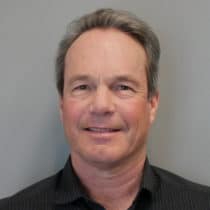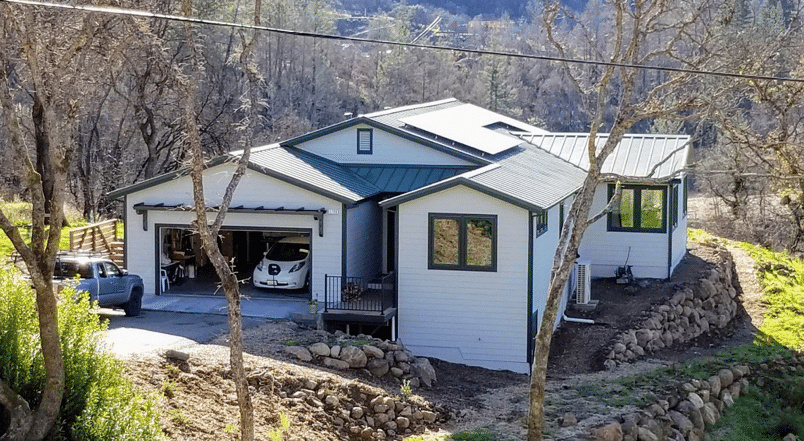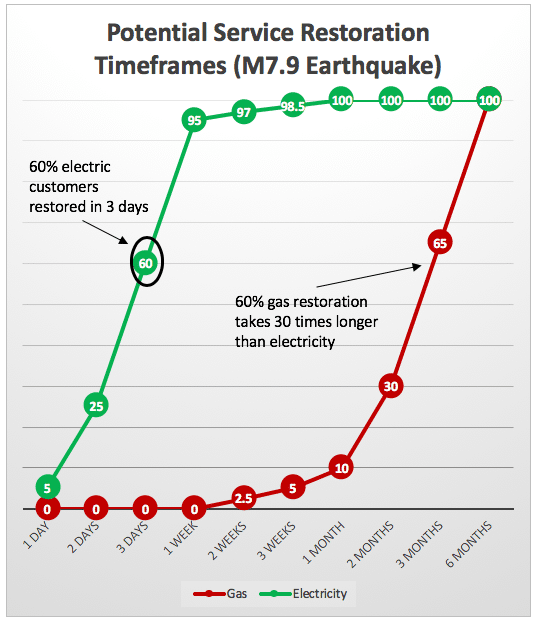By John Sarter, Program Manager – North Bay Community Resilience Initiative, Clean Coalition

At a time when all the news about climate change seems abysmal, there are rays of hope. Berkeley, California, has become the first major city to ban the use of natural gas in new construction. Over 50 other cities in California are poised to follow.
This is part of a positive trend to go all-electric and decarbonize — to eliminate sources of greenhouse gas (GHG) emissions, including from all fossil fuels like natural gas.
Why we can and should eliminate gas from new construction
Not too long ago, natural gas was seen as a bridge to the renewable energy future, as its GHG emissions were thought to be much lower than those from coal and oil. However, recent reassessments of gas’s lifecycle emissions and environmental impacts — from extraction by fracking, drilling, and other means to end-use burning for heat and electricity — show that the leakage during gas extraction and transport combined with emissions from combustion make gas far more damaging than previously thought.
Given the additional fact that it is now cheaper to bypass the entire gas system for new buildings and go all-electric, it’s a no-brainer to eliminate gas from all new building projects and communities. Making this cost flip possible are advances in new high-efficiency heat pump technologies for HVAC, water heating, and even clothes drying; highly efficient induction cooking; electric vehicles (EVs); and other advances. When you factor in the harmful effects of gas in the home — unregulated toxic fumes of burned and unburned gas emissions increasing rates of asthma, bronchitis, lung cancer, and heart disease — going all-electric is a clear win for public health and safety.

How we can electrify existing buildings
The next challenge is to decarbonize existing buildings. There are many inefficient older structures to address before our communities and states can completely wean off natural gas. This problem can be overcome, but it will take more time.
By providing incentives to electrify appliances, vehicles, and essentially everything that now burns fossil fuels, as well as incentives for energy efficiency retrofits, we can transform our existing infrastructure. The constant cost reductions surrounding solar, wind, and energy storage will help achieve this goal. A multi-agency bi-coastal working group of building science organizations known as Realize is working out the details of efficiency retrofits in order to create a just and equitable transition away from fossil fuels. This transition will create new solutions and plentiful jobs — jobs that will mostly remain local. We can address climate change strongly and maintain or even improve a robust economy.
The goal is lofty but essential: to begin reversing the damage that climate change is causing now and will increasingly cause moving forward. Anything less is unacceptable for the sake of our children and future generations.
The pressing need for resilience
As more communities make significant commitments to address climate change through electrification, a new and ever-growing need must also be addressed: resilience.
Even in the face of today’s relatively limited effects of climate change, resilience is already a pressing need. As climate impacts grow, resilience becomes ever more important. Thus, while it is extremely important to electrify as rapidly as possible, it is critical to enhance resilience ahead of the growing climate emergency.
Does eliminating sources of fossil fuel decrease resilience? Not if it’s done right and includes making our electricity infrastructure more resilient.
Natural gas is inherently dangerous and not resilient. Gas line explosions make frequent headlines, and the associated infrastructure is highly susceptible to fires, earthquakes, terrorism, and other disasters. For example, gas service takes 30 times longer than electricity to restore after large earthquakes:

Solar+storage microgrids as a resilience solution
The fundamental resilience solution is based on local solar and other distributed energy resources (DER), especially as part of community microgrids and facility microgrids, even nanogrids at the residential level. DER coordinated into microgrids provide unparalleled resilience that could never be matched by the historic energy system that relies on centralized fossil fuel infrastructure and vulnerable transmission grids. Community microgrids deliver economic, environmental, and resilience benefits to communities; smaller microgrids deliver the same benefits at a facility level.
Along with local renewables, energy storage is a key DER solution. Solar+storage can be combined at any level to provide resilience and eliminate points of failure that impact large geographic areas. Renewables+storage are the foundation of microgrids, which can be configured like layers of an onion: if the outer layer is damaged, there are deeper layers of protection. The more distributed an energy system is designed to be, the more layers it has and the more resilience it offers. Significant examples of community microgrids are happening in the Santa Barbara, California region, including Montecito, and in Calistoga.
The grid as we know it will morph into an interconnection of layered microgrids, each layer having the capability to operate independently if needed for any reason:
- The outer layer is a large community microgrid with wholesale distributed generation (WDG) renewables and storage, including largely commercial-scale solar+storage that can protect both at the community layer and at deeper site-level layers, depending on circumstances.
- Deeper layers serve individual buildings, including down to single-family homes.
- All the layers interconnect to share renewables+storage for balancing energy at whatever microgrid scenario is currently active.
To facilitate electrification and microgrids, the Clean Coalition has developed Electrification & Community Microgrid Ready (ECMR) guidelines, intended to enhance building codes and assist real estate developers. The ECMR guidelines provide details for achieving full electrification and a facility microgrid while incorporating the wiring and communications required for participating in a larger community microgrid that comes later. This document should be part of the reach code for any municipality with ambitions for electrification and resilience.
Enabling the transition to a resilient energy future
The beauty of the transition to resilient energy solutions is that it happens smoothly over time. To a great extent microgrids are a bottoms–up solution, starting with critical community facilities as well as homes and businesses. What the transition does require is innovations in policy and market mechanisms, and aligning key stakeholders, including property owners, utilities, municipal leadership, solution providers, and community members. In general, DER promote equity in development and ownership by greatly expanding investment opportunities that are individually small and local.
This idea is similar in concept to the development and growth of the internet — except with energy instead of data. Interestingly, the internet will greatly facilitate this transition by enabling instantaneous communications. Utility asset investment should shift from centralized to distributed solutions. The astronomical costs of centralized generation and transmission can be repurposed in part to fund distributed assets as the microgrid systems grow. The dangers of long–range transmission have become alarmingly clear amidst an increasing torrent of devastating fires in California.
The technologies for microgrids exist today, and they are ready to deploy. The solutions will comprise a system of widely distributed but highly coordinated local solar and other DER that grow like a beautiful and resilient garden. The time is now, and the need is great to electrify our communities while ensuring unparalleled resilience.
The views and opinions expressed in this article are the author’s own, and do not necessarily reflect those held by pv magazine.
This content is protected by copyright and may not be reused. If you want to cooperate with us and would like to reuse some of our content, please contact: editors@pv-magazine.com.







By submitting this form you agree to pv magazine using your data for the purposes of publishing your comment.
Your personal data will only be disclosed or otherwise transmitted to third parties for the purposes of spam filtering or if this is necessary for technical maintenance of the website. Any other transfer to third parties will not take place unless this is justified on the basis of applicable data protection regulations or if pv magazine is legally obliged to do so.
You may revoke this consent at any time with effect for the future, in which case your personal data will be deleted immediately. Otherwise, your data will be deleted if pv magazine has processed your request or the purpose of data storage is fulfilled.
Further information on data privacy can be found in our Data Protection Policy.